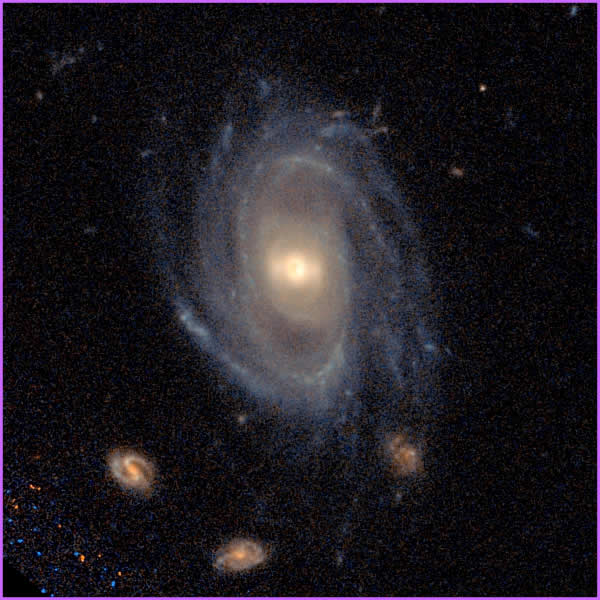 |
 |
A Barred Spiral Galaxy This galaxy belongs to a class known as "spiral galaxies", so named because of the intrincate double-armed spiral pattern that is clearly visible in the disk of the galaxy. Our own Milky Way also possesses a spiral pattern and would look similar if we could view it from the outside. The "arms" of the spiral are traced out in this galaxy by bright regions of starlight, which are sometimes clumpy in appearance. These bright clumps of light are clusters of newly-formed stars. Their light is dominated by a small fraction of very massive, very hot stars. These massive stars are much brighter than the more numerous Sun-like stars and the light they produce has a blue color because they are very hot. However, they also burn through their supply of fuel very quickly and thus have lifespans of only a few million years---very short compared to the 10 billion year life-expectancy of the Sun! These bright blue clumps therefore trace out areas where stars have formed recently. |
So why do galaxies tend to form stars in a spiral pattern? Stars tend to form in the regions with the densest gas. The spiral arms in the disk of a galaxy are density patterns and the star formation traces out the density peaks in the gas. Models show that spiral density patterns in rotating disks of matter can be resonant patterns that tend to reinforce and perpetuate themselves once they are triggered. It thus appears that small gravitational perturbations in the rotating disks can grow into the large-scale spiral patterns observed in galaxies. |
If you look closely at the central region of the galaxy above, you may notice several things. The light coming from the central part of the galaxy appears redder than the light coming from the spiral arms. In this region of the galaxy, the massive hot stars which produce blue light and dominate the total brightness of the spiral arms have burned through their supply of fuel and exploded as supernovae. Only the slow-burning, cool, less massive stars are left and their light is redder because they are cooler. The blue spiral arms are the sites of the most active star formation; much less star formation is going on at the center where the light is dominated by fainter, cooler, older stars. |
There also appears to be a brighter bar-like structure near the galaxy center, extending roughly horizontally. This central bar is another type of gravitational instability, although less well understood. The bar probably plays a role in funnelling gas into the center of the galaxy where it may fuel central star formation or be swallowed up by a massive black hole. Bars are found in more than half of all spiral galaxies but are thought to be transitory phenomena that reform multiple times over the life of a galaxy. |